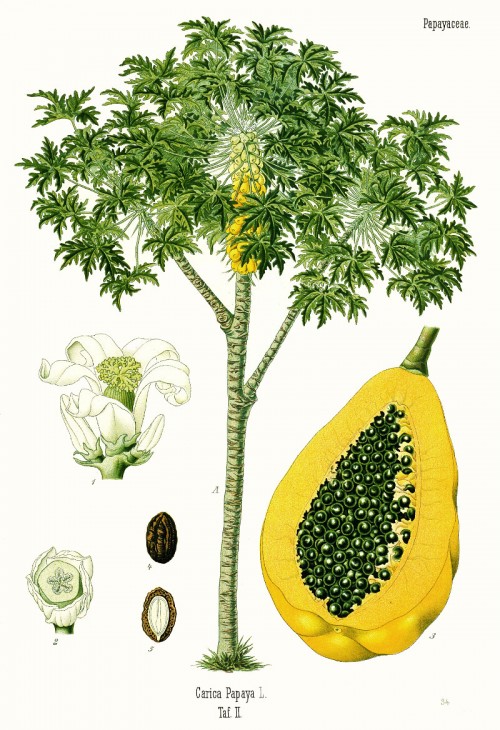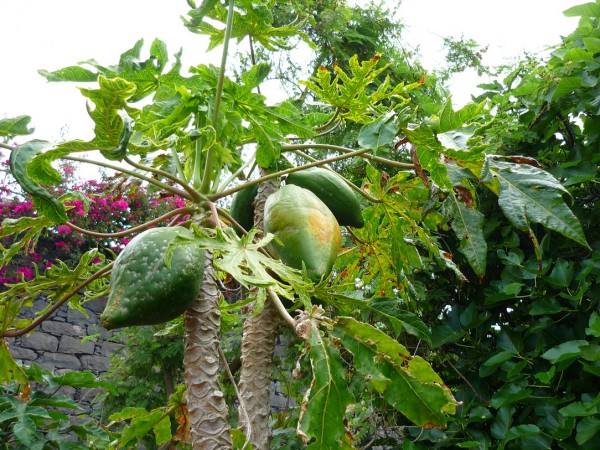Dies ist eine alte Version des Dokuments!
Carica papaya L. - Caricaceae - papaya, melon tree, Papaya
Evergreen tree-like plant, up to 6m tall, native to tropical South America, cultivated elsewhere; leaves arranged like a tuft at the top of the stem, large, long-petioled, palmately lobed; inflorescences axillary; flowers - the male ones hanging in pendulous panicles, the yellowish-white female in shortly branched clusters; ovary with 3-5 united carpels, 5 stigmas; fruits large, obovate to pear-shaped; pulp yellow to orange-red, central cavity with many dark grey seeds. The ripe fruit flesh of the papaya is usually eaten raw.
There are male, female, and hermaphrodite papaya plants. These forms are expressed in the plant’s flower.
http://www.ctahr.hawaii.edu/oc/freepubs/pdf/F_N-5.pdf
Raw papain (Papainum crudum) is the dried and cleansed latex of C.papaya. The enzyme mixture produced from raw papain is also called papain and contains papaya proteinase I (papain), chymopapain (A,B), and papaya peptidase A (caricain).
Esters were the most abundant compounds of the aroma volatiles from fresh papaya fruit, with methyl butanoate (48%) as major constituent. Products of benzyl glucosinolate degradation were identified, but no benzyl isothiocyanate was found.
[Volatile components of papaya (Carica papaya L.) with particular reference to glucosinolate products., MacLeod, A.J., Pieris, N.M., Journal of Agricultural and Food Chemistry, Vol.31(5), 1983, 1005-1008]
Methyl butanoate, ethyl butanoate, 3-methyl-1-butanol and 1-butanol were found to be the major volatile components of fresh papaya fruit. The esters of lower fatty acids were considered to contribute much to the typical papaya flavour.
[Volatile components of papaya (Carica papaya L., Maradol variety) fruit. Pino, J. A., Almora, K., Marbot, R., Flavour and fragrance journal, Vol.18(6), 2003, 492-496]
„Many plants contain latex that exudes when leaves are damaged, and a number of proteins and enzymes have been found in it. The roles of those latex proteins and enzymes are as yet poorly understood. We found that papain, a cysteine protease in latex of the Papaya tree (Carica papaya, Caricaceae), is a crucial factor in the defense of the papaya tree against lepidopteran larvae such as oligophagous Samia ricini (Saturniidae) and two notorious polyphagous pests, Mamestra brassicae (Noctuidae) and Spodoptera litura (Noctuidae). Leaves of a number of laticiferous plants, including papaya and a wild fig, Ficus virgata (Moraceae), showed strong toxicity and growth inhibition against lepidopteran larvae, though no apparent toxic factors from these species have been reported. When the latex was washed off, the leaves of these lactiferous plants lost toxicity. Latexes of both papaya and the wild fig were rich in cysteine-protease activity. E-64, a cysteine protease-specific inhibitor, completely deprived the leaves of toxicity when painted on the surface of papaya and fig leaves. Cysteine proteases, such as papain, ficin, and bromelain, all showed toxicity. The results suggest that plant latex and the proteins in it, cysteine proteases in particular, provide plants with a general defense mechanism against herbivorous insects.“ [Papain protects papaya trees from herbivorous insects: role of cysteine proteases in latex. Konno, K., Hirayama, C., Nakamura, M., Tateishi, K., Tamura, Y., Hattori, M. and Kohno, K., The Plant Journal, Vol.37, 2004, 370–378]
„Application of solid-phase microextraction and simultaneous distillation–extraction combined with GC–FID, GC–MS, aroma extract dilution analysis, and odour activity value were used to analyse volatile compounds from papaya fruit cv. Red Maradol and to estimate the most odour-active compounds. The analyses led to the identification of 137 compounds; 118 of them were positively identified. Twenty-five odorants were considered as odour-active compounds and contribute to the typical papaya aroma, from which ethyl butanoate, benzyl isothiocyanate, 1-hexen-3-one, (E)-β-ionone, and methyl benzoate were the most odour-active compounds.“
[Odour-active compounds in papaya fruit cv. Red Maradol., Pino, J.A., Food chemistry, Vol.146, 2014, 120-126]

Köhler, F.E., Medizinal Pflanzen, vol. 3: t. 34 (1890)
http://plantgenera.org/species.php?id_species=205571

